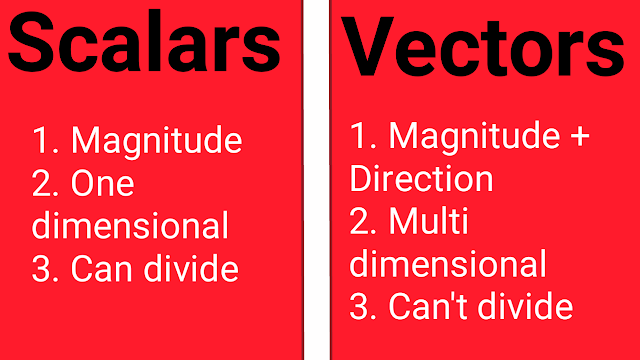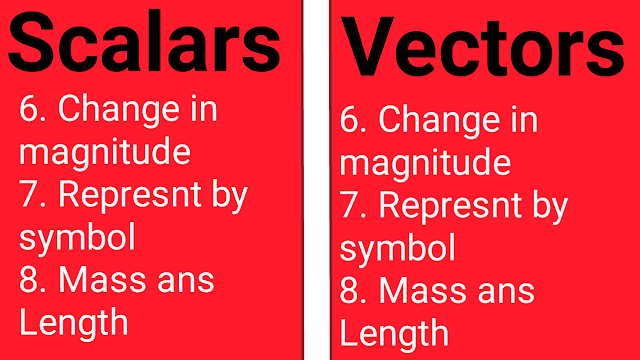In Physics, we have to deal with lots of physical quantities. All the measurable quantities are known as physical quantities. Some examples of physical quantities are length, mass, velocity, weight, acceleration, etc. While teaching physical quantities, when we tell the students that all the measurable quantities are known as physical quantities, some students frequently ask the question that which quantities are not measurable. I try to provide an answer to this question with the help of examples. Quantities like love, honesty, and kindness are not measurable, therefore, we can’t say they are physical quantities. For example, if you love someone, you just express your love in words rather than in kilograms, kilometers, or miles. Let’s move toward the basic topic. These physical quantities are divided into two types. These two types of physical quantities are known as scalars and vectors. When we have to deal with lots of physical quantities, it is difficult for us to differentiate scalars from vectors. The difference between scalars and vectors is given below;
What are Scalars?
A physical quantity that is fully described just with the help of magnitude is known as a scalar. It means that to describe the scalar quantity, we just require a number. Some essential examples of scalars are speed, mass, temperature and time, etc. If you go to a shop to buy sugar, you can easily buy the sugar just by telling the magnitude of the sugar. For example, if you want to buy one kg of sugar, you just need to tell them that you need one kg of sugar and you don’t need to tell the direction. It means that you don’t need to tell the shopkeeper that you require one kg of sugar in the East, West, or North.
Some Essential Points to Remember about Scalar Quantities
If we want to understand scalar quantities effectively, we should also try to remember these essential points;
i. The scalar quantities only have magnitudes and these quantities don’t have directions.
ii. If you are changing the scalar quantity, it means that you are changing the magnitude of the scalar quantity.
iii. These are one-dimensional.
iv. To add and subtract the scalar quantities, you will have to follow the basic rules of algebra.
v. We can’t resolve the scalar quantities. It means that scalar quantities have the same values in all directions.
What are Vectors?
A physical quantity that is completely described with the help of magnitude, as well as direction, is known as a vector quantity. It means that to completely describe a vector quantity, you will have to tell magnitude as well as direction. Some essential examples of vector quantities are velocity, acceleration, force, etc. If you want to accelerate a vehicle, you will have to ask someone to apply force on it. When you are asking him to apply force on the vehicle, you will have to tell him to apply force either in the backward direction or in the forward direction.
Some Essential Points to Remember about Vector Quantities
If we want to effectively understand the vector quantities, we should try to remember these essential points;
i. All the vector quantities are comprised of magnitude and direction. Therefore, you can easily describe the vector quantities with the help of magnitude as well as direction.
ii. If you are changing the vector quantity, it means that you are changing the magnitude as well as the direction of the vector quantity.
iii. These quantities have up to three dimensions.
iv. To add two or more vectors, you will have to use the head-to-tail rule.
Key Differences Between Scalar and Vector Quantities
To differentiate between scalars and vectors, you will have to understand these key differences.
i. Description
The first main difference between scalar and vector quantities is that they are described in two different ways. First, if you want to describe the scalar quantities, you will have to provide magnitudes only and you don’t need to provide the direction. On the other hand, if you want to describe the vector quantities, you will have to provide magnitude as well as direction.
ii. Dimensional
The scalar quantities are always one-dimensional. On the other hand, vector quantities can be one, two, or three-dimensional.
iii. Division
We can divide a scalar quantity with the help of another scalar quantity. On the other, we can’t divide a vector quantity with another vector quantity.
iv. Direction
We can’t resolve the scalar quantities. Its reason is that a scalar quantity has the same value in all directions. On the other hand, we can easily resolve a vector quantity in mutually perpendicular directions with the help of the adjacent angles.
v. Relationship Between Scalars and Vectors
When we perform any mathematical operation between a scalar quantity and a vector quantity, its result is always in the form of a vector quantity.
vi. Mathematical Rules
To perform different mathematical operations between two or more two scalar quantities, we have to follow ordinary rules of algebra like subtraction, addition, multiplication, etc. On the other hand, to perform different mathematical operations between two or more two vector quantities, you will have to follow vector algebra rules.
vii. Change
While using scalars and vectors in Physics, sometimes, we have to change them. If we are changing the scalar quantity, it means that you are changing the magnitude of the scalar quantity. On the other hand, if you are changing a vector quantity, you are not only changing the magnitude of the vector quantity but you are also changing the direction of the vector quantity.
viii. Representation
If we want to represent a scalar quantity, we can easily represent it with the help of its symbol. Some examples are m and s etc. On the other hand, if we want to represent a vector quantity, we will have to use the symbol as well as an arrow which has two parts head and tail.
Examples
Scalars and vectors are two different quantities. Therefore, these two quantities also have different examples. Some examples of scalars are mass, length and time, etc. On the other hand, some examples of vectors are acceleration, force, and velocity, etc.
Relevant Posts:
Differentiate Scalars from Vectors in the Given Set of Physical Quantities
After understanding the key differences between scalars and vectors, you can easily differentiate the scalars from vectors in the given set of physical quantities. Differentiate the scalars from the vectors in the following set of physical quantities; Length, velocity, accelerations, mass, temperature, and force. You can easily differentiate scalars and vectors just by knowing which quantities are completely described with the help of help magnitude only and which quantities require magnitude as well as direction for their complete description.
Scalar Quantities
i. Length
ii. Temperature
iii. Mass
Vector Quantities
i. Velocity
ii. Force
iii. Acceleration
Similarities Between Scalars and Vectors
Along with understanding the key differences between these two quantities, you should also know that there are also some similarities between these two quantities. These similarities are given below;
i. While describing the differences between these two quantities, we have not discussed the unit. Its reason is that both scalars and vectors require a unit for their complete description. Therefore, it is a similarity between these two quantities and it is not a difference.
ii. As scalars are vectors are two kinds of physical quantities. Therefore, both scalars and vectors are measurable quantities.
iii. Another similarity between these two quantities is that we require dimension to completely describe these two quantities.
iv. Either we are discussing the scalar quantities or the vector quantities we are discussing the physical quantities.
Conclusion
After a brief explanation of the scalars and vectors, we can conclude our discussion with a few points. The main difference between scalars and vectors is in their direction because to describe the scalar quantity, we don’t require direction and to describe the vector quantity, we require direction. For example, if we are discussing the scalars, it means that we are discussing the amount of the object. On the other hand, if we are discussing vectors, it means that we are discussing their amount as well as direction.










